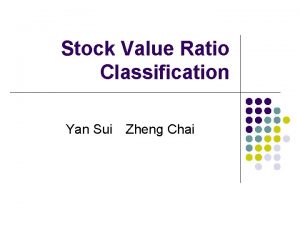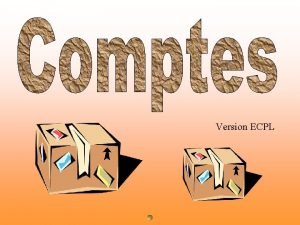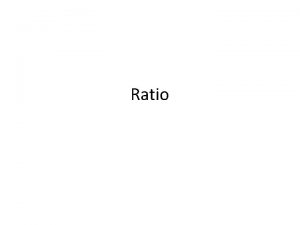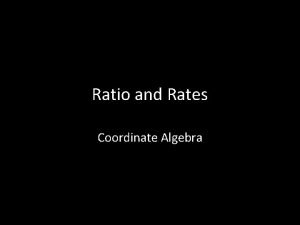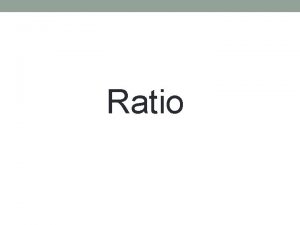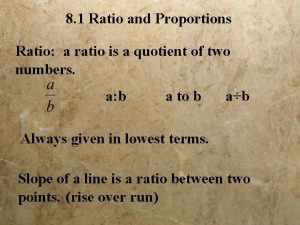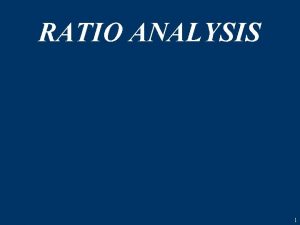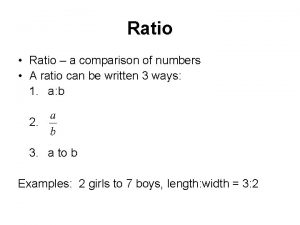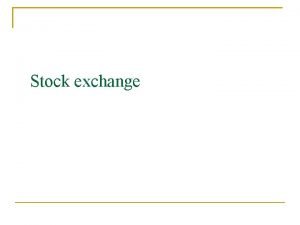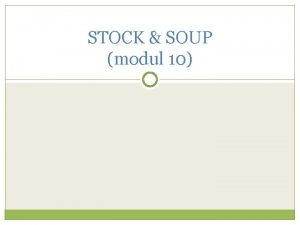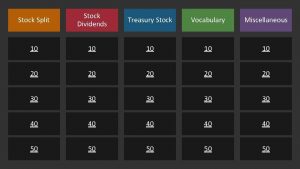Stock Value Ratio Classification Yan Sui Zheng Chai



























- Slides: 27

Stock Value Ratio Classification Yan Sui Zheng Chai

Classification l l MKV/BKV is an indicator of investors’ confidence in a particular company Being able to predict this ratio gives insight to predicting the stock prices

Outline l l l Define Problem Data Method Initial Result Discussion

Definition l Market Value l l The current quoted price at which investors buy or sell a share of common stock or a bond at a given time. Also known as "market price". Book Value l l l The accounting value of a firm. The total value of the company's assets that shareholders would theoretically receive if a company were liquidated. Per share: total value divided by number of shares

Problem Definition l l l Given training data, predict the ratio for the future Classification vs Prediction Problem Need to define the classes (more later)

Problem Definition l l Why do we can about the ratio? Book value stays relatively constant and could be estimated Could estimate market price if we know this ratio and estimated book value


Outline l l l Define Problem Data Method Initial Result Discussion

Data l Dow Jones Industrial Average (Dow 30) l l Consists of 30 of the largest and most widely held public companies in the United States. E. g. American Express, AT&T, Boeing, Citigroup, Exxon Mobil, GM, GE, Intel, etc.

Data l l l wrds from Wharton Attributes are from CRSP/COMPUSTAT Merged database Book value and market value are from COMPUSTAT North America database l High, low, and closing prices for each month are available

Problem… l Book value is updated annually l l Market value is updated daily l l 1 per year 365 per year What can we do?

Our Approach l l l Estimate “annual market price” of a stock by averaging its high, low and closing prices over 12 months. Market value = estimated market price Another possibility: l Interpolate annual book values

Data Preprocessing l Data Cleaning ~400 attributes --> 68 attributes (possibly more) l l l Estimate annual market value Divide the MKV/BKV ratios into a number of classes Currently, there are 5 classes

1995 - 2005, 330 total observations

ratio class # of Ex R <= 2 0 20 2 < R <=4 1 114 4 < R <=6 2 97 6 < R <= 10 3 69 R > 10 4 30

Outline l l l Define Problem Data Method Initial Result Discussion

Attributes l l l Hundreds or even thousands possible attributes Using too many attributes may result in overfitting Want to select a subset that work best for the task

Attribute Selection l l Select a subset of attributes to use Algorithms considered l l Greedy Algorithm Genetic Algorithm (genoud package in R)

Genetic Algorithm

Evaluation Function l l l Produce a score of how a particular subset of features work (error rate) Minimization problem Possible candidates l l l SVM Neural Network Etc.

Outline l l l Define Problem Data Method Initial Result Discussion

Classify on the training data using 10 features Error = abs(predicted - actual)

Number of features

Top features

Explanation of Result l l Works well on training set When applied on new data, accuracy is around 40 -50%

To Do List l l l Retain more (non-atomic) attributes Try other evaluation functions Classification on daily ratio Other feature selection algorithms? Hopefully, find out which features are more influential in predicting market price for some stocks

Question?
 Chai ratio
Chai ratio Penciptaan nilai adalah
Penciptaan nilai adalah Chai gin tsen
Chai gin tsen Yidong chai
Yidong chai Jinxiang chai
Jinxiang chai Czarif chai abdullah
Czarif chai abdullah Bà tôi ngồi cạnh tôi chải đầu
Bà tôi ngồi cạnh tôi chải đầu Mỉm cười nhìn đóa hoa lòng nghi ngờ tan vỡ
Mỉm cười nhìn đóa hoa lòng nghi ngờ tan vỡ Chai mail curtain
Chai mail curtain Kop chai lai lai
Kop chai lai lai Jinxiang chai
Jinxiang chai Long-term debt preferred stock and common stock
Long-term debt preferred stock and common stock Brown stock adalah
Brown stock adalah Characteristics of bonds
Characteristics of bonds Stock initial - stock final
Stock initial - stock final Zheng he images
Zheng he images Jianmin zheng
Jianmin zheng Lida zheng md
Lida zheng md This map shows that the silk road
This map shows that the silk road Should we celebrate the voyages of zheng he dbq answer key
Should we celebrate the voyages of zheng he dbq answer key Indicates ambition coolheadedness and fierceness
Indicates ambition coolheadedness and fierceness Bojian zheng
Bojian zheng Alvin zuyin zheng
Alvin zuyin zheng Zheng
Zheng Zheng he
Zheng he Shuran zheng
Shuran zheng Cindy zheng
Cindy zheng Whyjay zheng
Whyjay zheng
